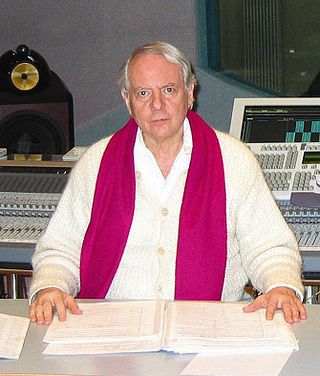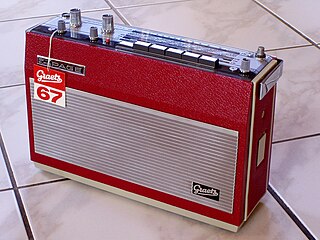
The Oeldorf Group was a musicians' collective active in Germany in the 1970s. Based in the village of Oeldorf, near Cologne, their performances emphasized live-electronic music.

The Oeldorf Group was a musicians' collective active in Germany in the 1970s. Based in the village of Oeldorf, near Cologne, their performances emphasized live-electronic music.
The Oeldorf Group was founded in 1972 or 1973 and remained active until about 1978 or 1979. Live-electronic music was a particular emphasis, though they also performed all kinds of new and avant-garde music, as well as traditional repertory. [1] [2] ) In fact, contrast of old and new music was an essential feature of the Oeldorf Group's concerts. [3]
The group took its name from the village of Oeldorf (a part of the municipality of Kürten, 40 kilometers east of Cologne and seven kilometers from the central village of Kürten), where they lived and worked in a rented farmhouse. [4] They had their own studio for electronic music and studio productions, and in the barn adjacent to the house they were able to present concerts for audiences up to about 300 people, although they also performed in various other places. They also published their own music. The core members were Peter Eötvös (at that time best known as a composer) who performed electronics and keyboards, his wife, the pianist Pi-hsien Chen, the violinist/violist and composer Joachim Krist, electronics specialist and composer Mesías Maiguashca, who also played keyboards, and Maiguashca's wife, the cellist Gaby Schumacher. They were closely associated with the Cologne-based Feedback Studio, consisting of David C. Johnson, Johannes Fritsch, and Rolf Gehlhaar. [2] [5]
Through their long-standing contact with the Westdeutscher Rundfunk (WDR), the Oeldorf Group was able to receive commissions for compositions, invitations to perform in the Musik der Zeit concert series, as well as having many of their summer concerts recorded for the late-night broadcasts of WDR3. [6] One example was Oeldorf 8 by Mesías Maiguashca, a two-year retrospective portrait of the Oeldorf Group commissioned by the WDR. It consists of a series of eight short pieces for four instrumentalists (clarinet, violin, cello, electric organ/synthesizer) and tape, which may be played either simultaneously or continuously without a break. The score is dedicated to Maiguashca's three Oeldorf colleagues who, together with the composer, premiered the composition at the Darmstädter Ferienkurse in 1974.( [7] [8]

The Oeldorf Summer-night Concerts began as no more than private country musical soirées for a small circle of composers, but quickly grew to become a byword in the Cologne music scene. The 1973 summer season consisted of three concerts, the last of which took place on 23 June and consisted entirely of premieres of new compositions: David C. Johnson's Progranca—ein Oeldœuvre, Ulrich Stranz's Déja-vue, Silvio Fortić's Drei Lieder aus dem unvollendeten und unvollendbaren Zyklus 'la merde de siècle', and Emmanuel Nunes's The Blending Season. [9]
In 1978 the group joined with the British Hydra Ensemble to inaugurate the newly built hall of the London Goethe Institute in a week of concerts and seminars organised by Rolf Gehlhaar. [10]
Live electronics were an important aspect of the Oeldorf performances, as illustrated by the Portuguese composer Emmanuel Nunes's 73-Oeldorf-75, for two electric organs and electronics, which was written for the group. [8]
According to Maiguashca,
Stockhausen's group was different from both ours and Feedback because it was fully professional. His group was based at Westdeutsche Rundfunk and had the advantage of having "state of the art" professional equipment and setups.[ [lower-alpha 1] ] No expense was spared. A Stockhausen concert involved sometimes truck loads of WDR equipment, and a brace of technicians. We were much more modest. Our equipment was semi-professional: we carried our own loudspeakers and did all the setups ourselves. [11]
In addition to the core members, guest artists also frequently appeared. In the 1973 summer series, Australian dancer Philippa Cullen (who had come to Germany to work with Karlheinz Stockhausen, who lived nearby) performed with a Theremin connected to a synthesizer, and the Slovenian violinist Miha Pogačnik played Bach's partitas for solo violin. [5] [12] Clarinetists Walter Seyfarth, David Smeyers, Suzanne Stephens, and Beate Zelinsky appeared at various times, and Stockhausen performed in his own composition Herbstmusik , which was written for the group in 1974. [5] [8] In 1976, the Hungarian violinist János Négyesy performed the violin sonatas by Charles Ives. [13]

Gesang der Jünglinge is an electronic music work by Karlheinz Stockhausen. It was realized in 1955–56 at the Westdeutscher Rundfunk studio in Cologne and is Work Number 8 in the composer's catalog. The vocal parts were supplied by 12-year-old Josef Protschka. It is exactly 13 minutes, 14 seconds long.

The EMS Synthi 100 was a large analogue/digital hybrid synthesizer made by Electronic Music Studios, London, originally as a custom order from Radio Belgrade for what was to be the Radio Belgrade Electronic Studio, largely thanks to contact between composer Paul Pignon, then living in Belgrade, and Peter Zinovieff. The synthesiser was designed by David Cockerell and documented in detail in 1971. The cost at that time was £6,500. The last unit built by EMS was number 30. Afterwards, one final unit was built by Datanomics, who bought assets from EMS when the company folded in 1979. The redesigned unit was sold to Gabinete de Música Electroacústica, Cuenca, Spain.
David C. Johnson is an American composer, flautist, and performer of live electronic music.

Aus den sieben Tagen is a collection of 15 text compositions by Karlheinz Stockhausen, composed in May 1968, in reaction to a personal crisis, and characterized as "Intuitive music"—music produced primarily from the intuition rather than the intellect of the performer(s). It is Work Number 26 in the composer's catalog of works.
Herbert Eimert was a German music theorist, musicologist, journalist, music critic, editor, radio producer, and composer.
Mesías Maiguashca is an Ecuadorian composer and an advocate of Neue Musik, especially electroacoustic music.

Hymnen is an electronic and concrete work, with optional live performers, by Karlheinz Stockhausen, composed in 1966–67, and elaborated in 1969. In the composer's catalog of works, it is No. 22.
John McGuire is an American composer, pianist, organist, and music editor.

Klang —Die 24 Stunden des Tages is a cycle of compositions by Karlheinz Stockhausen, on which he worked from 2004 until his death in 2007. It was intended to consist of 24 chamber-music compositions, each representing one hour of the day, with a different colour systematically assigned to every hour. The cycle was unfinished when the composer died, so that the last three "hours" are lacking. The 21 completed pieces include solos, duos, trios, a septet, and Stockhausen's last entirely electronic composition, Cosmic Pulses. The fourth composition is a theatre piece for a solo percussionist, and there are also two auxiliary compositions which are not part of the main cycle. The completed works bear the work (opus) numbers 81–101.

Kurzwellen, for six players with shortwave radio receivers and live electronics, is a composition by Karlheinz Stockhausen, written in 1968. It is Number 25 in the catalog of the composer's works.

Spiral, for a soloist with a shortwave receiver, is a composition by Karlheinz Stockhausen, written in 1968. It is Number 27 in the catalogue of the composer's works.

Pole (Poles), for two performers with shortwave radio receivers and a sound projectionist, is a composition by Karlheinz Stockhausen, written in 1970. It is Number 30 in the catalogue of the composer's works.

Stop is a composition for orchestra by Karlheinz Stockhausen, work-number 18 in the composer’s catalogue of works, where two performing realisations are also found as Nr. 18½ and Nr. 18⅔.

Oktophonie (Octophony) is a 1991 octophonic electronic-music composition by Karlheinz Stockhausen. A component layer of act 2 of the opera Dienstag aus Licht, it may also be performed as an independent composition. It has a duration of 69 minutes.
Unsichtbare Chöre is an eight-channel electronic-music composition by Karlheinz Stockhausen. A component part of the opera Donnerstag aus Licht, it may also be performed as an independent composition, in which form it is designated "ex 49" in the composer's catalog of works.
In music, the Cologne School is a loosely associated group of composers and performers of the generation that came to prominence in the 1970s, who lived and worked in the city of Cologne, Germany.

Für kommende Zeiten is a collection of seventeen text compositions by Karlheinz Stockhausen, composed between August 1968 and July 1970. It is a successor to the similar collection titled Aus den sieben Tagen, written in 1968. These compositions are characterized as "Intuitive music"—music produced primarily from the intuition rather than the intellect of the performer(s). It is work number 33 in Stockhausen's catalog of works, and the collection is dedicated to the composer's son Markus.

The Studio for Electronic Music of the West German Radio was a facility of the Westdeutscher Rundfunk (WDR) in Cologne. It was the first of its kind in the world, and its history reflects the development of electronic music in the second half of the twentieth century.

Europa-Gruss is a composition by Karlheinz Stockhausen for wind ensemble with optional synthesizers, and is assigned Number 72 in the composer's catalogue of works. It has a duration of about twelve-and-a-half minutes.

Ensemble is a group-composition project devised by Karlheinz Stockhausen for the 1967 Darmstädter Ferienkurse. Twelve composers and twelve instrumentalists participated, and the resulting performance lasted four hours. It is not assigned a work number in Stockhausen's catalogue of works.
Notes
Sources